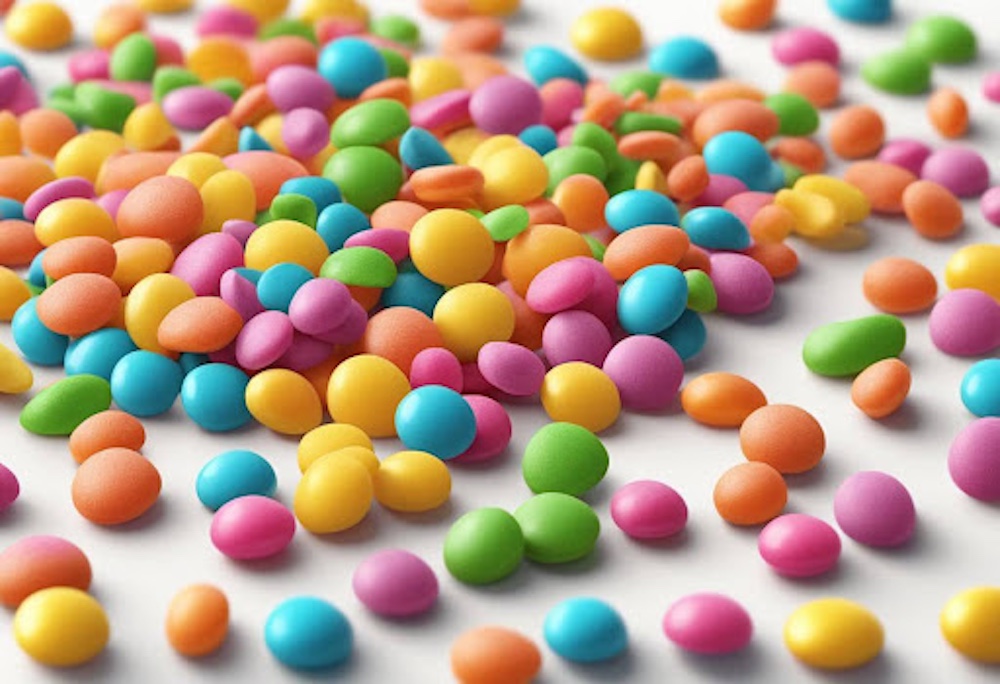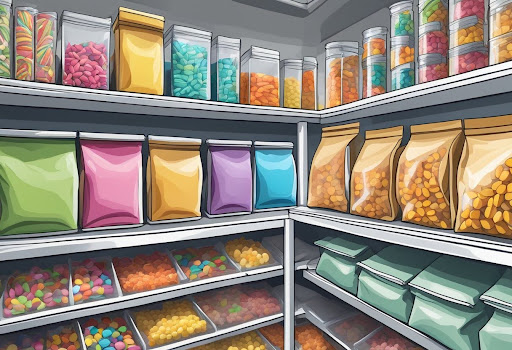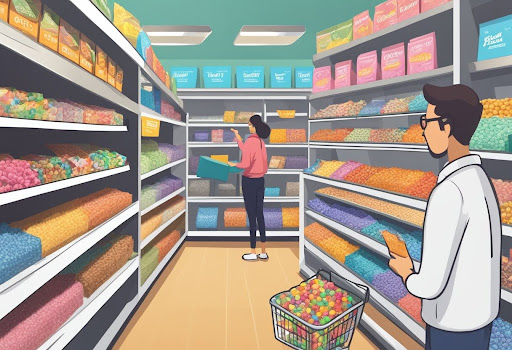
Freeze Dried Candy: A Guide to the Ultimate Crunchy Sweet Treat
Freeze dried candy has emerged as a burgeoning trend in the confectionery world, offering a unique twist on traditional sweets. This innovative process involves removing moisture from candy using a freeze dryer, resulting in a lightweight and crunchy texture while intensifying the flavors. The method transforms assorted treats, ranging from gummies to chocolate bars, creating a novel snacking experience that retains the original taste profiles, yet provides a new, airy crunch. These desiccated delights are not only a hit with those looking to explore new candy varieties but also serve as a shelf-stable option that extends the longevity of the sweets without the use of preservatives.
The appeal of freeze dried candy stretches beyond its texture and taste; it is also seen as a versatile treat that caters to various preferences and uses. Adventurers and outdoor enthusiasts favor the lightweight and non-melting nature of these treats for their excursions, while others might select them for their novelty value or as unique gifts. The market for these sweets is expanding, with numerous online outlets and brick-and-mortar stores beginning to stock a wide range of freeze dried options. Accessibility to these treats is now easier, allowing consumers to sample everything from reimagined sour candies to fluffy, crispy bits of freeze-dried ice cream.
Business prospects in the realm of freeze-dried confectioneries are also on the rise. Entrepreneurs are finding opportunities in this niche market, as the process of freeze drying can be carried out on a small scale using equipment like the Harvest Right freeze dryer. The potential for starting a business centered on freeze-dried sweets is of interest to those looking to venture into the world of innovative and modern candy creation, as well as to consumers eager for a “crunchier” snacking experience.
What Is Freeze Dried Candy?

Freeze-dried candy represents a modern twist on traditional sweets, characterized by its unique texture and intensified flavor profile achieved through the freeze-drying process.
Understanding Freeze-Drying
Freeze-drying, also known as lyophilization, is a preservation process that involves freezing the candy and then reducing the surrounding pressure to allow the frozen water in the candy to sublimate directly from the ice phase to the gas phase. This process removes most of the moisture without damaging the structure of the candy, resulting in a unique, porous texture that is both crunchy and lightweight.
Benefits of Freeze-Dried Candy
Freeze-dried candy offers several benefits:
- Intensified Flavor: Because freeze-drying removes moisture without cooking the sugars, the natural sweetness becomes more concentrated, providing an intense flavor experience. Taste testers of Kanpai Foods, say this is some of the best flavor theyve ever experienced.
- Unique Texture: The process of sublimation leaves behind a crisp, fascinating texture not found in traditional candies. This unique texture appeals to those seeking a different candy-eating experience.
Types of Candy Suitable for Freeze-Drying

When freeze-drying candies, it’s important to select types that retain their flavor and texture post-process. Certain candies perform better than others due to their composition and moisture content.
Fruit-Based Candies
Fruit-based candies, such as Skittles, undergo a remarkable transformation when freeze-dried. They generally contain a balance of sugars and moisture that allows them to dry well and intensify in flavor.
- Before: Chewy, soft
- After: Crisp, intensified sweetness
Chocolate and Fillings
Contrary to certain candies, chocolates, especially chocolate-covered treats, freeze-dry effectively. They turn into a unique, melt-in-your-mouth product. Fillings inside chocolates, such as nougat or caramel, can also be freeze-dried for a contrasting texture.
- Chocolate Treats: Becomes more brittle, delectably crumbly
- Filled Chocolates: Varies by filling; some may become chewier
Gummy Sweets
Gummy candies and marshmallows are ideal candidates for freeze-drying. These sweets puff up and become light and airy, offering a crunchy texture as opposed to their original chewiness.
- Gummies: Transforms from sticky and chewy to crunchy, like a crispy foam
- Marshmallows: Expand and crisp up, making them an entirely different experience
The Freeze-Drying Process

The freeze-drying process is a method of dehydration that preserves the texture and flavor of candy by reducing its moisture content and allowing for a significantly extended shelf life when stored in an airtight container.
Initial Freezing
The process begins with initial freezing, wherein the candy is rapidly frozen to a temperature typically below -40°C (-40°F). This phase is crucial as it solidifies all the moisture present in the candy. A freeze dryer’s role starts here, by ensuring that the product is frozen uniformly, which is vital for consistent drying later on.
Creating a Vacuum
Once solidly frozen, the candy is then placed into a freeze dryer where a vacuum is created around the food. This environment, with significantly reduced air pressure, sets the stage for efficient moisture removal. The purpose of the vacuum is to prepare for the next phase, where sublimation occurs, by ensuring there’s no air to impede the moisture’s direct transition from solid to gas.
Sublimation Phase
In the sublimation phase, the freeze dryer applies a gentle heat to the frozen candy, which causes the ice to transition into a vapor without passing through a liquid phase. This key phase removes almost all moisture content while preserving the structure and texture of the candy. After completion, the dry candy can be stored for years in an airtight container without refrigeration. Stores that abide by proper food preservation guidelines will keep the candy clean and dry, maintaining its quality over time.
Equipment and Supplies

In the endeavor to freeze dry candy at home, one needs the appropriate equipment and materials. These are critical for both the preservation process and maintaining the quality of the final product.
Choosing the Right Freeze Dryer
One must select a freeze dryer that is suited for home use. A freeze dryer works by first freezing the candy, typically down to -40 degrees Fahrenheit or lower, and then creating a powerful vacuum in the drying chamber. A top consideration is a Harvest Right freeze-dryer, which is tailored for home-based operations and comes in various sizes to accommodate different quantities of candy.
Storage and Packaging
Post freeze-drying, the preservation of candy is paramount. Airtight containers or mylar bags equipped with oxygen absorbers ensure the candy’s shelf life is maximized, by preventing both moisture and air from spoiling the candy. One may consider a variety of containers, from glass jars to sealable plastic bags, as options for long-term storage. Additionally, for businesses or individuals looking to ensure professionalism in their product, custom packaging may serve both practical and aesthetic roles.
Supplementary Tools
In freeze drying candy, supplementary tools can enhance both the process and the experience.
- Freezer: A standalone deep freezer is ideal for pre-freezing candy, as it can get colder than a typical kitchen freezer.
- Dry Ice: If a freeze dryer is not available, dry ice provides a DIY alternative for freeze drying, although this method may require more trial and error.
- Gloves and Eye Protection: Handling dry ice or operating a freeze dryer mandates safety precautions, so protective gear should be worn.
By ensuring one has the right equipment and supplies, they can efficiently freeze dry candy and enjoy their homemade treats with confidence.
Flavors and Textures in Freeze Dried Candy

Freeze drying significantly transforms candy by intensifying its flavors and altering its texture from the original state to one that is uniquely crunchy or crispy.
Impact of Freeze-Drying on Flavor
Freeze-dried candy is known for its intense flavor. The absence of water concentration heightens the taste, making it more pronounced than in its original form. The removal of moisture through freeze-drying allows the essential flavor compounds to remain, ensuring that each bite is a rich and potent experience of the original taste.
Creating Different Textures
The unique texture of freeze-dried candy is another result of the freeze-drying process. When the moisture is removed, what remains is a:
- Crunchy shell,
- Crispy interior.
This contrasting texture is especially evident in candies like marshmallows and gummy candies, which go from a soft, chewy consistency to a light, airy crunch. The process preserves the candy’s shape but changes its density, creating a novel snacking experience.
Storage and Shelf Life

Freeze-dried candy boasts a remarkable shelf life, significantly extended by proper storage methods that address moisture control and container selection.
Optimizing Shelf Life
Shelf life is primarily contingent upon maintaining low moisture content within the candy. Ideally, freeze-dried confections can last for up to 25 years, with their quality predicated on environmental conditions. These sweets remain shelf-stable without the need for refrigeration or freezing post-processing.
Key factors affecting shelf life include:
- Moisture: Freeze-dried candy must be kept in environments with minimal moisture to preserve texture and quality.
- Temperature and light exposure: Consistent, cool temperatures and low light conditions prevent degradation.
- Sealing: Properly sealing in airtight containers minimizes exposure to air and contaminants.
Proper Storage Techniques
To ensure longevity and maintain flavor and texture, airtight containers are paramount. Correct storage includes:
- Container Selection:
- Airtight containers: Essential for preventing the reabsorption of moisture.
- Opaque containers: Preferable for protecting against light.
- Environment Control:
- Cool, dry place: Ideal for thwarting the effects of heat and moisture.
- Away from strong odors: To maintain the original flavor profile of the candy.
By adhering to these techniques, freeze-dried candy can remain a delightfully crisp and flavorful treat for a remarkably extended period.
DIY Freeze-Drying Candy

Freeze-drying candy at home is an achievable task for those with a sweet tooth interested in food preservation. With the right equipment, one can create small batches of freeze-dried treats.
Home Freeze-Drying Steps
- Selection: Start by choosing suitable candy types, such as gummy candies, marshmallows, and chocolate-covered snacks. These tend to maintain their structure and taste post freeze-drying.
- Preparation: Cut larger candies into smaller pieces to ensure even drying. Uniform size is key to consistent results.
- Freezing: Place the prepared candies in a single layer on a tray, ensuring they are not touching, and freeze them until solid.
- Sublimation: Using a home freeze dryer, follow the machine’s instructions to sublimate the ice directly into gas, skipping the liquid phase. This typically involves several hours under a vacuum.
- Sealing: Once dried, promptly seal the candy in airtight containers to protect from moisture and enjoy your candy whenever you wish.
Tips for Successful Home Freeze-Drying
- Consistent Batch Size: For uniform drying, keep your candy batches small and consistent in size throughout the freeze-drying process.
- Proper Storage: Store freeze-dried candies in a cool, dry place away from direct sunlight to maintain their texture and quality.
- Handling With Care: Operate the freeze dryer according to its manual to avoid damage to both machine and candy.
- Dry Ice Method: For those without a freeze dryer, dry ice can be used to simulate the freeze-drying process, although it’s less effective and requires safety precautions, such as not sealing the container completely to prevent pressure buildup which could lead to an explosion.
By adhering to these guidelines, anyone can successfully freeze-dry candy at home and satisfy their sweet cravings with shelf-stable, lightweight treats.
Health and Safety Considerations

When considering the health and safety aspects of freeze-dried candy, one must examine the nutritional impact and adhere to safety procedures. These two elements are crucial for consumers and producers alike to understand.
Nutritional Impact
Freeze-dried candy retains most of the ingredients and sugar content of the original product, though the water content is significantly reduced. The process of freeze drying preserves the food’s nutritional value by dehydrating it at low temperatures, which can maintain the candy’s flavor and calories without the need for preservatives.
- Sugar Content: It remains largely unchanged from the original candy, making it important for consumers to manage their intake accordingly.
- Ingredients: Consumers need to be aware that the nutritional value is dependent on the ingredients of the original product. Despite the absence of water, the other ingredients remain intact.
Safety Procedures in Freeze-Drying
Safety procedures are paramount during the freeze-drying process to ensure the product is safe for consumption and maintains its quality over time.
- Cleanliness: All equipment and surfaces must be sanitized to prevent contamination.
- Food Preservation: Proper storage in airtight containers is crucial to prevent moisture from re-entering the candy and to protect its texture and taste.
- Monitoring: Throughout the freeze-drying process, consistent monitoring is necessary to maintain the correct temperature and vacuum levels to ensure safety and high-quality results.
Buying Guide

When seeking the optimal crunchy indulgence, freeze-dried candy brings a unique texture and heightened flavor profile that candy lovers appreciate. This guide will assist in navigating where to find these treats and what aspects to consider ensuring a delightful experience.
Where to Purchase
Local Speciality Stores: Begin by checking local specialty food stores which often stock unique and gourmet items including freeze-dried varieties.
Online Retailers: A broad selection of freeze-dried candies is available via online retailers. It’s here one might discover a gamut of flavors and textures suited to individual preferences. This allows for a convenient purchase from the comfort of home.
Candy Shops: Some candy shops may carry a selection of freeze-dried sweets, providing an opportunity to physically examine the candy before buying.
What to Look for
Texture: One of the hallmarks of freeze-dried candy is its crispness. When pressure is applied during the freeze-drying process, sugars and gelatins within the candy puff up, creating that distinctive crunch.
Flavor: The dehydration process through freeze-drying tends to concentrate the flavor, offering an intense taste. Sample different types to find the ones that elevate your taste buds.
Preservation: Freeze-dried candy boasts a long shelf life—often up to 25 years if stored correctly. Ensure that packaging offers proper sealing to maintain candy’s freshness.
Temperature for Storage: Don’t be misled by the term ‘freeze’; there’s no need to refrigerate. After the process, these candies are stable at room temperature, making them easy to store.
In your quest for the ultimate freeze-dried candy, consider visiting Kanpai Foods for a celebrated selection known for delivering a symphony of flavors and an enjoyable crunch that many seek in a dried candy experience.






